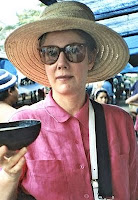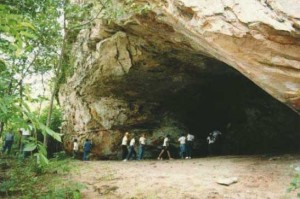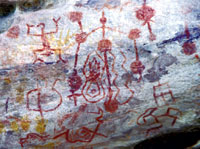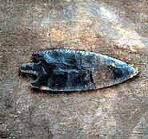When Europeans first came to South America, they were awed by the grand civilizations of the Andes. The jungle, on the other hand, was for Europeans a place of dark and savage mystery, inhabited by primitive and ferocious warriors. Two interlocking assumptions about the Amazon have persisted to this day. The first is that the Amazon is a place of virgin wilderness, untouched by human cultivation or management; the second is that the people of the Amazon have always been — as they were found to be by twentieth-century anthropologists — small bands living by gathering, hunting, fishing, and slash-and-burn agriculture.
Still, stories of El Dorado — a grand and complex civilization in the jungle, the equal of the great Andean cities — have circulated since Europeans first arrived. One eighteenth-century Portuguese mercenary and gold-seeking bandeirante wrote in his memoirs, kept in the manuscript department at the National Library of Brazil, how he had discovered, in the heart of the jungle, “a large, hidden, and very ancient city.” Such accounts have been assumed to be be untrue. After all, what civilization could have emerged in such harsh subsistence conditions?
These assumptions may be slowly changing.
 |
| Anna Roosevelt |
Archeologist Anna Curtenius Roosevelt — a great-granddaughter of Theodore Roosevelt and a winner of the MacArthur “genius” award — is a professor of anthropology at the University of Illinois at Chicago. She began working in the Amazon in 1983, and spent several years collecting evidence from a cave called Caverna da Pedra Pintada, Cave of Painted Rock, at Monte Alegre in the uplands of Brazil, overlooking the Amazon River. The cave contained the remains of buried fruits from nearby rainforest trees; mussel shells and fish bones from the river; drops of the red pigment used to make the paintings on the cave walls; and, in the same layer of deposit, stone projectile points buried near the mouth of the cave.
Apparently the cave was occupied several times a year by people who camped in the main cavern, cooked meals, knapped stone spear points, and made paintings, including what may be calendrical or astronomical calculations.
 |
| Caverna da Pedra Pintada |
In 1996, in an article in the journal Science, Roosevelt reported that a combination of carbon-14 dating for the organic matter and thermoluminescence dating for the stone artifacts and sediment showed that humans had lived in the cave as early as 11,200 years ago — twice as long ago as scientists had previously estimated human presence in the Amazon.
That report caused quite a stir. The most widely accepted theory of the peopling of South America is that, 11,000 years ago, over a period of 3,000 years, Paleoindians from the Siberian steppes followed big-game herds across the Bering Strait to Alaska on a land bridge that has since been submerged, and then migrated through what is now the western United States and Central America into South America, settling along the Andes. These migrants brought with them distinctive and beautifully worked spear points, known as the Clovis tradition, with which they hunted large game in the open, temperate, upland habitats in the interior of North America. Paleoindians in the Andes and those in North America had similar cultures. They avoided the humid rainforests of the Amazon.
That is why Roosevelt’s claim was so unsettling. “This really changes the picture of migrations and ecological adaptations of early Americans,” Roosevelt says. “People were not even supposed to be in this part of the hemisphere at this time.”
 |
| Cave paintings |
An important piece of evidence for Roosevelt’s theories is a spear point found in the Cave of Painted Rock. The long narrow Clovis spear point — the earliest dated examples are between 10,900 and 11,200 years old — was designed to be struck deep into the bodies of large animals such as mastodons, mammoths, and bison, causing them to bleed out from internal injuries. The point that Roosevelt found is short and triangular, with a barbed base more suitable for spearing fish and smaller game, where the point may pass entirely through the body. Similar points, none as well documented, are found in South American museums.
“We found strong evidence that a culture quite distinct from the North American Paleoindian culture, but contemporary with it, existed more than 5,000 miles to the south,” Roosevelt says. “Paleoindians traveled far and adapted to a diverse range of habitats. The existence of distinct cultures east of the Andes suggests that North American big-game hunters were not the sole source of migration into South America.”
The Paleoindians of the Amazon were therefore not descendants of the mammoth hunters of North America; rather, they were contemporaries, with their own distinctive art and technology adapted to their jungle and riverine environment. “Clovis is evidently just one of several regional traditions,” Roosevelt concludes. “Clearly, Paleoindians were able to adapt to a broad range of habitats. In the Amazon, they developed a long-term adaptation to the humid tropical forest.”
 |
| Non-Clovis spear point |
These conclusions have been challenged, most often by questioning the dates that Roosevelt has assigned to the artifacts. Richard Reanier of the University of Alaska concluded that the Amazon site had been settled a thousand years later than the Clovis site in New Mexico, giving a thousand-year window within which Paleoindians could migrate to the Amazon. Similarly, C. Vance Haynes of the University of Arizona revised the statistical reading of the evidence to make the cave no more than 10,500 years old, and thus allow its culture to be a descendant of Clovis.
Others think that Roosevelt’s broad conclusions may have been too hasty. “It’s tantalizing evidence that the adaptations of some of the first Americans may have been different from what we thought,” said Dr. John Rick, a Stanford University anthropologist. “But we can hardly use a single site for a whole revision of New World archeology.”
Roosevelt herself has never displayed an inclination to be conciliatory. John Douglas, a University of Montana colleague who co-authored the Science paper, notes that “Anna tends to cut a controversial figure in the field. She’s often right, but she has a way of stirring people up.” Dr. Gordon Willey, a professor emeritus of archeology at Harvard, puts it this way: “Anna’s a good researcher and very passionate about being right.”
Roosevelt is unmoved by her critics. “You have to face the idea that some opinions won’t change,” she says. “But in the end, if you have the evidence, you will be in the textbook, not them.”
Roosevelt made another very significant discovery at the cave — pottery that dates back to 7,500 years ago, more than 2,000 years older than the earliest pottery found in Mesoamerica or the Andes. Apparently the hunting and foraging artists of the Cave of Painted Rock had, over thousands of years, developed into the earliest ceramic-producing culture in the Americas, without the influence of Andean high civilization.

- Previous Post: Yuwipi Man
- Next Post: Primer Festival de la Selva Peruana
- More Articles Related to: Indigenous Culture, The Amazon


